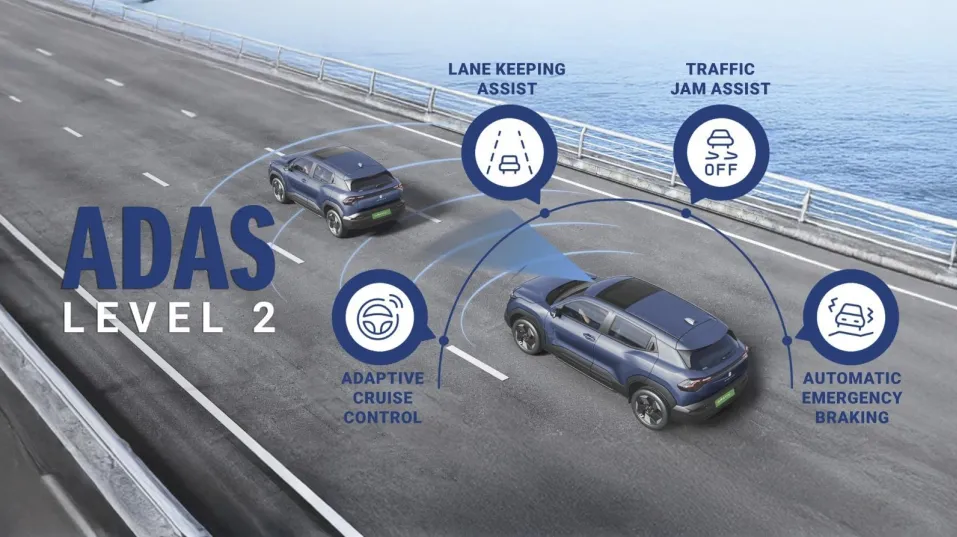ADAS Level 2 Explained: How It Works, Features & Benefits

ADAS Level 2 offers partial driving automation, where the vehicles can control steering & acceleration/ deceleration under specific conditions. ADAS is categorised into levels ranging from 0 to 5. Levels 0 to 2 are considered Advanced Driver-Assistance Systems, where the driver is always responsible, while Levels 3 to 5 represent increasing degrees of autonomous driving, with the system taking on more responsibility.
Key Features of ADAS Level 2
- Adaptive Cruise Control: Maintains a set speed & distance from other vehicles. It automatically accelerates and decelerates the vehicles.
- Lane Keeping Assist: Keeps vehicle within its lane, reducing the risk of accidental lane departures.
- Traffic Jam Assist: Makes driving less stressful by automatically managing speed, distance, & steering in traffic jams
- Automatic Emergency Braking: Automatically applies the brakes to avoid or mitigate a collision when the system detects a potential crash.
Differences Between ADAS Level 1 and Level 2
Differences between ADAS Level 1 and Level 2 based on the SAE (Society of Automotive Engineers) classification:

How does ADAS Level 2 Work?
To drive itself, a car uses cameras & radars to constantly scan its surroundings. This data is sent to a computer that controls the car's steering and speed.
Lane Keeping Assist (LKA)
How it works: Cameras read lane markings on the road.
Action: If the car strays out of the lane without signalling, the system will nudge it back to the centre.
Adaptive Cruise Control (ACC)
How it works: Radar and cameras track the distance to the car in front.
Action: Retains a set speed but slows down or accelerates automatically to maintain a safe following distance.
Lane Centering Assist
How it works: Utilises cameras to continuously follow lane markings.
Action: Makes subtle steering inputs to maintain the vehicle in the middle of its lane.
Automatic Emergency Braking (AEB)
How it works: Sensors identify obstacles or slower-moving vehicles in front.
Action: In the event of an impending collision and the driver fails to respond, the system operates the brakes.
Traffic Jam Assist
How it works: Combines lane keeping and adaptive cruise control at low speeds.
Action: Assists the vehicle to steer, brake, and accelerate in stop-and-go traffic, easing driver stress.
Driver Monitoring System
How it works: Cameras or sensors monitor the driver's eye movement or hand position.
Action: If the system identifies inattention or hands off the wheel, it provides alerts or can suspend assistance.
Benefits of ADAS Level 2
- Less Stressful Driving: Driving in our traffic can be really stressful. This system takes some of that stress away. It makes driving more comfortable.
- Safer Roads: It helps you stay in your lane & keep a safe distance. Also, it reduces the risk of accidents. More Comfortable Journeys: Long drives become less tiring & daily commutes are less of a headache.
- Saves Fuel: Smooth acceleration & braking- controlled by the system, can sometimes save you some fuel.
- Better Resale Value: Cars with these features are becoming more popular. So, they might hold their value better
Challenges & Limitations of ADAS Level 2
- Road Markings: The Lane Departure Warning System feature needs clear road markings to work. If the lines are faded, it won't work well.
- Weather: Heavy rain, fog, or dust can affect the sensors. These factors make them less reliable.
- Don't Get Lazy: You still need to pay attention & drive. You cannot completely rely on the system too much.
- Expensive: Cars with ADAS Level 2 are usually more expensive.
- Road challenges: Our roads have lots of surprises, like animals & potholes, which can confuse the system.
The Future of ADAS: Moving Toward Level 3 & Beyond
ADAS Level 2 has just evolved. Cars will get even smarter in the future & eventually, they might be able to drive themselves in certain situations. But for now, Level 2 is a big step towards safer and more comfortable driving.
